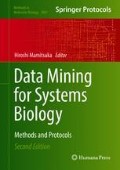Abstract
Identifying drug-target interactions is crucial for the success of drug discovery. Approaches based on machine learning for this problem can be divided into two types: feature-based and similarity-based methods. By utilizing the “Learning to rank” framework, we propose a new method, DrugE-Rank, to combine these two different types of methods for improving the prediction performance of new candidate drugs and targets. DrugE-Rank is available at http://datamining-iip.fudan.edu.cn/service/DrugE-Rank/.
Access this chapter
Tax calculation will be finalised at checkout
Purchases are for personal use only
References
Keiser MJ, Setola V, Irwin JJ et al (2009) Predicting new molecular targets for known drugs. Nature 462(7270):175–181
Lounkine E, Keiser MJ, Whitebread S et al (2012) Large-scale prediction and testing of drug activity on side-effect targets. Nature 486(7403):361–367
Nunez S, Venhorst J, Kruse CG (2012) Target-drug interactions: first principles and their application to drug discovery. Drug Discov Today 17:10–22
Ding H, Takigawa I, Mamitsuka H, Zhu S (2014) Similarity-based machine learning methods for predicting drug–target interactions: a brief review. Brief Bioinform 15(5):734–747
Zheng X, Ding H, Mamitsuka H, Zhu S (2013) Collaborative matrix factorization with multiple similarities for predicting drug-target interactions. In: Proceedings of the 19th ACM SIGKDD international conference on Knowledge discovery and data mining. ACM, pp 1025–1033
Takigawa I, Mamitsuka H (2013) Graph mining: procedure, application to drug discovery and recent advance. Drug Discov Today 18(1–2):50–57
Liu T (2009) Learning to rank for information retrieval. Found Trends Inf Retr 3(3):225–331
Li H (2011) A short introduction to learning to rank. IEICE Transactions 94-D(10):1854–1862
Yuan Q, Gao J, Wu D et al (2016) DrugE-Rank: improving drug-target interaction prediction of new candidate drugs or targets by ensemble learning to rank. Bioinformatics 32(12):i18–i27
Law V, Knox C, Djoumbou Y, Jewison T, Guo AC, Liu Y, Maciejewski A, Arndt D, Wilson M, Neveu V et al (2014) Drugbank 4.0: shedding new light on drug metabolism. Nucleic Acids Res 42(D1):D1091–D1097
Bleakley K, Yamanishi Y (2009) Supervised prediction of drug-target interactions using bipartite local models. Bioinformatics 25(18):2397–2403
Van LT, Marchiori E (2013) Predicting drug-target interactions for new drug compounds using a weighted nearest neighbor profile. PLoS One 8(6):e66952
Van LT, Nabuurs SB, Marchiori E (2011) Gaussian interaction profile kernels for predicting drug-target interaction. Bioinformatics 27(21):3036–3043
Xia Z, Zhou X, Sun Y, Wu L (2009) Semi-supervised drug-protein interaction prediction from heterogeneous spaces. In: The Third International Symposium on Optimization and Systems Biology, vol 11. pp 123–131
Rao H, Zhu F, Yang G, Li Z, Chen Y (2011) Update of profeat: a web server for computing structural and physicochemical features of proteins and peptides from amino acid sequence. Nucleic Acids Res 39(Suppl 2):W385–W390
Acknowledgments
This work has been partially supported by National Natural Science Foundation of China (Grant Nos: 61572139), MEXT KAKENHI #16H02868, and FiDiPro by Tekes.
Author information
Authors and Affiliations
Corresponding author
Editor information
Editors and Affiliations
Rights and permissions
Copyright information
© 2018 Springer Science+Business Media, LLC, part of Springer Nature
About this protocol
Cite this protocol
Deng, J., Yuan, Q., Mamitsuka, H., Zhu, S. (2018). DrugE-Rank: Predicting Drug-Target Interactions by Learning to Rank. In: Mamitsuka, H. (eds) Data Mining for Systems Biology. Methods in Molecular Biology, vol 1807. Humana Press, New York, NY. https://doi.org/10.1007/978-1-4939-8561-6_14
Download citation
DOI: https://doi.org/10.1007/978-1-4939-8561-6_14
Published:
Publisher Name: Humana Press, New York, NY
Print ISBN: 978-1-4939-8560-9
Online ISBN: 978-1-4939-8561-6
eBook Packages: Springer Protocols

